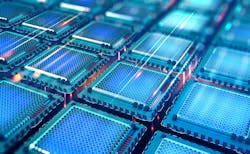Air Force asks industry to develop quantum computing software algorithms for next-gen command and control
ROME, N.Y. – U.S. Air Force researchers are asking industry to develop new quantum computing algorithm software for machine automation and machine learning in future command, control, communications, and intelligence systems.
Officials of the Air Force Research Laboratory Information Directorate in Rome, N.Y., issued a broad agency announcement (FA8750 AFRL RIK ROME NY 13441-4514 USA) on Thursday for the Quantum Information Services project.
Researchers want companies to submit white papers for research, design, development, concept testing, experimentation, integration, evaluation, and delivery of technologies to support Air Force research in command and control.
Quantum computing seeks to capitalize on quantum mechanics to deliver a huge leap forward in processor performance to solve particularly difficult problems.
The project has five focus areas: quantum algorithm and computation; quantum information processing; memory-node-based quantum networking; superconducting hybrid quantum platforms; and quantum information sciences.
Quantum algorithm and computation seeks to develop quantum software algorithms for today's computers, including noisy intermediate-scale quantum (NISQ) computers and quantum annealing and adiabatic quantum computers.
Researchers are interested in quantum software algorithms for machine learning, neural networks, optimization, quantum walks, unstructured searches, decision and risk analysis, hybrid classical and quantum algorithms, efficient quantum gate and circuit decomposition and characterization, protocols and algorithms for quantum photonic integrated waveguide chips, superconducting qubit, and trapped-ion platforms.
Quantum information processing concerns entanglement distribution, quantum information processing, and localand distributed quantum computation. The project will emphasize photon-based qubits including quantum integrated photonic circuitry, interactions between photon-based qubits, and other qubit technologies.
Other interests include quantum repeaters, high dimensional entanglement, efficient generation and measurement of quantum states, quantum channel characterization and discrimination, and measurement based quantum computation.
Researchers are focusing on photon-based qubits, single-photon and entangled-photons on demand, quantum algorithms employing cluster and graph states, trapped-ion qubits, superconducting qubits, quantum annealing or adiabatic quantum computation, and blind quantum computation.
Memory-node-based quantum networking includes quantum networking, quantum communication, and quantum information processing with an emphasis on trapped-ion qubits, superconducting qubits, integrated-circuit-based qubits, and entanglement distribution.
Focus areas include multi-node network connections, quantum transduction across frequency bands, interfacing heterogeneous qubit technologies, quantum information mapping between homogenous and heterogeneous qubit technologies, entanglement distribution, entanglement verification and validation, ultra-high vacuum technology, dilution refrigerator technology, laser development and laser control, and interfaces across different platforms.
Superconducting hybrid quantum platforms focuses on developing new quantum devices, new functionalities, and exploring fundamental quantum networking physics, with an emphasis on hybrid superconducting systems.
The focus includes cross-quantum technologies for interfacing superconducting qubits and circuitry with ion-trap systems, integrated photonic circuitry, and electromechanical and optomechanical systems; quantum and classical microwave-optical interfaces; developing 3D-integrated heterogeneous quantum architectures; chip-scale refrigeration; and quantum interfaces across large temperature gradients.
Quantum Information Sciences focuses on quantum communications, quantum networking, and quantum computing, with an emphasis on quantum bit technologies, quantum protocols for networking and computation, and enabling technologies.
Funding for this project will be about $20 million over the next two years.
Related: Top technology challenges this decade for the warfighter
Companies interested should email two-to-four-page white papers no later than 29 Sept. 2022 for 2023 funding, and by 29 Sept. 2023 for 2024 funding to the Air Force's Kristi Mezzano at [email protected].
Email technical questions to Kristi Mezzano at [email protected], or contracting questions to Amber Buckley at [email protected].
More information is online at https://sam.gov/opp/afdb23099e5b4275b211e72f6cef0861/view.
About the Author
John Keller
Editor-in-Chief
John Keller is the Editor-in-Chief, Military & Aerospace Electronics Magazine--provides extensive coverage and analysis of enabling electronics and optoelectronic technologies in military, space and commercial aviation applications. John has been a member of the Military & Aerospace Electronics staff since 1989 and chief editor since 1995.
